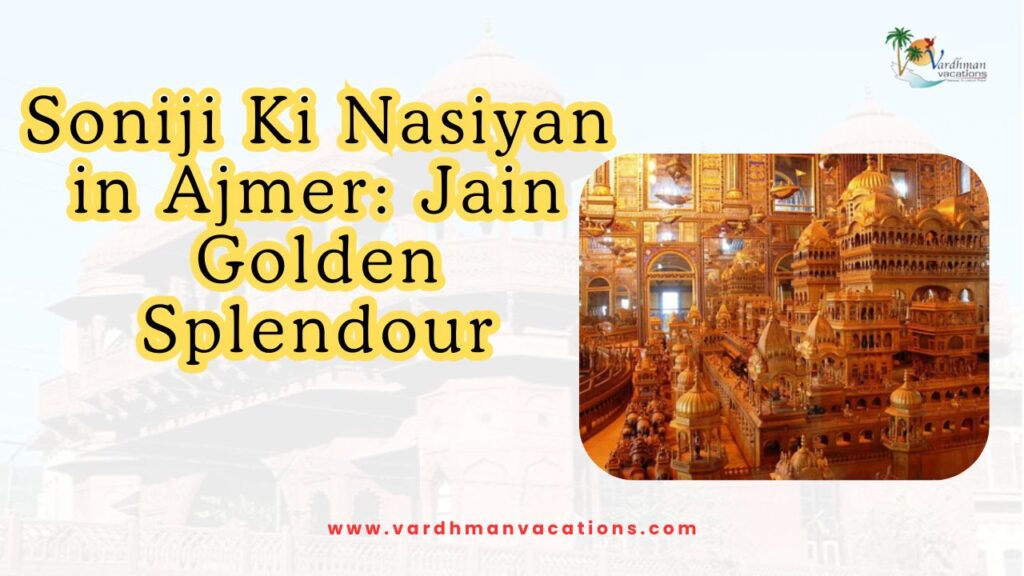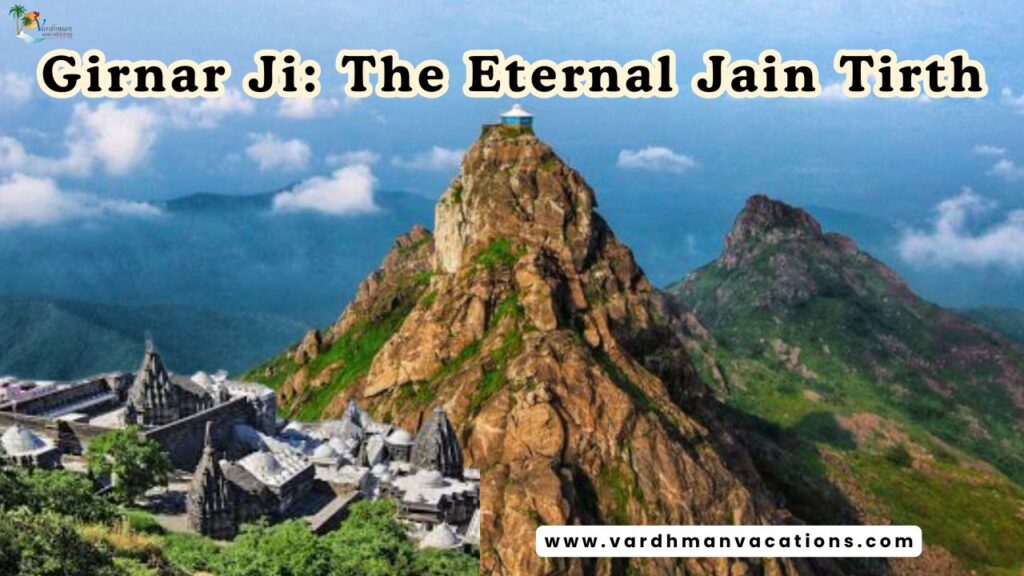India is one of the oldest civilizations in the world and has a rich and diverse cultural history. Over the centuries, many communities and rulers such as the Shakas, Hunas, and Kushans made India their home. Each of them left their mark, making India a treasure house of architectural styles and traditions.
Throughout history, India has seen the rise and fall of many great kingdoms. Each dynasty brought its own style, creating new monuments, temples, palaces, and forts. These structures not only shaped the destiny of the country but also added to its artistic and cultural beauty.
As you travel from North to South India, you will notice the changing designs and building techniques. From grand Mughal forts and palaces in the north to beautifully carved temples and Dravidian architecture in the south, every region has something unique to offer.
India is filled with impressive monuments and iconic landmarks that showcase its architectural brilliance. To make it easier, we have listed the 20 best architectural buildings in India that stand as symbols of beauty, history, and creativity.
Fatehpur Sikri
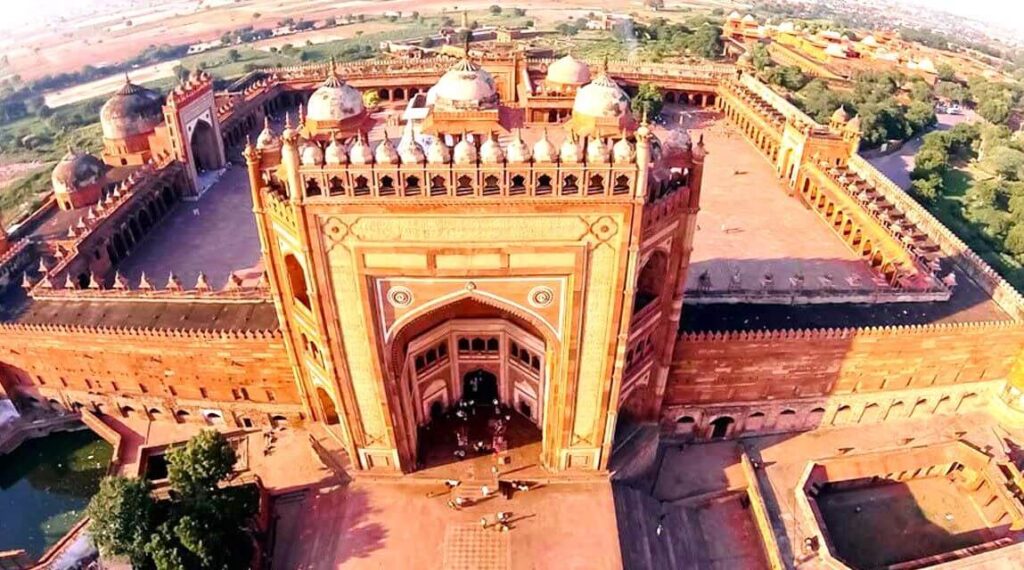
Fatehpur Sikri was built in 1573 AD by the great Mughal Emperor Akbar. It served as the capital city of the Mughal Empire for a short period. The entire complex reflects the grandeur, values, and beliefs of the Mughal dynasty.
What makes Fatehpur Sikri special is its blend of different architectural styles. You can see influences of Indian, Islamic, Persian, Hindu, and even Jain designs in its buildings. The city was built around the hospice of Sheikh Salim Chishti, a saint whom Akbar deeply respected.
The city is surrounded by walls on three sides, while a lake protects the fourth side, which was likely the main water source at that time. Inside the complex, there are several grand structures built for administration, residence, and religion.
Some of the most notable buildings include the Jama Masjid, Diwan-i-Khaas, Diwan-i-Aam, the tomb of Salim Chishti, and the grand Buland Darwaza, which is the most famous landmark of all.
Sadly, despite its beauty, Fatehpur Sikri was later abandoned. Akbar shifted his capital first to Lahore and later to Agra, leaving behind this architectural masterpiece as a reminder of Mughal glory.
Taj Mahal, Agra
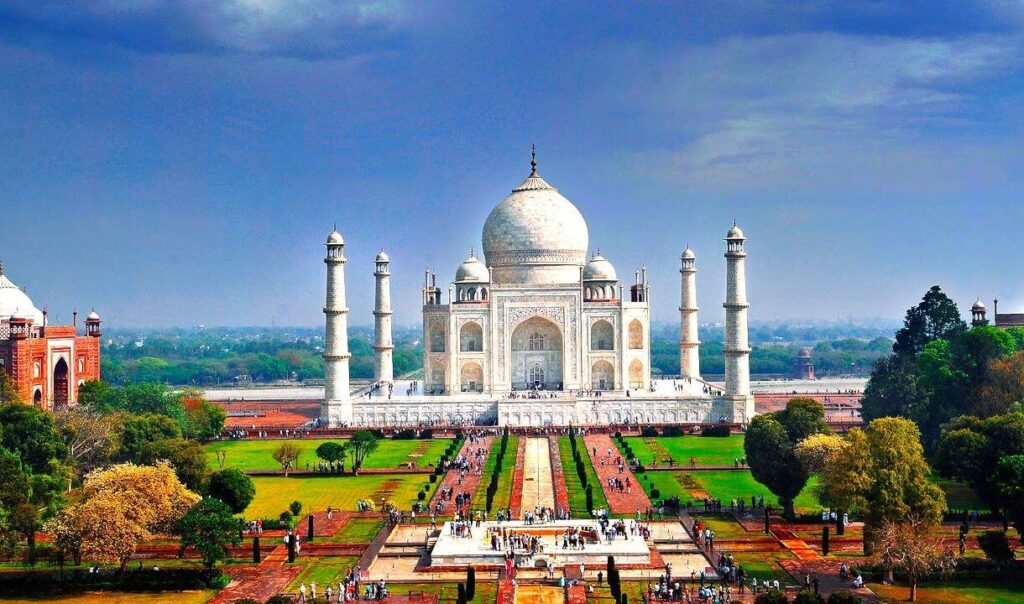
The Taj Mahal in Agra is one of the most famous landmarks in the world and is counted among the 7 Wonders of the World. Known for its breathtaking beauty, it is often seen as a symbol of eternal love.
This magnificent mausoleum was built by Mughal Emperor Shah Jahan in memory of his beloved wife Mumtaz Mahal, who passed away in 1631 at the age of 38 while giving birth to their fourteenth child. Heartbroken by her loss, Shah Jahan decided to create a monument that would forever honor their love.
Construction of the Taj Mahal began in 1632 AD and took around 22 years to complete, finishing in 1653 AD. It is said that nearly 22,000 artisans, including masons, calligraphers, and craftsmen, worked under the supervision of Ustad Ahmad Lahauri, the chief architect. The total cost of construction was about 32 million rupees at that time.
Built with shining white marble inlaid with precious and semi-precious stones, the Taj Mahal is not just a tomb but a grand architectural complex. It includes a paradise-like garden, fountains, reflecting pools, and a striking red sandstone mosque on one side. Many scholars believe its design was inspired by descriptions of paradise in Islamic texts.
Today, the Taj Mahal is more than just a historical monument. It is a timeless expression of love and devotion, attracting millions of visitors and couples who come to witness its beauty and reaffirm their love.
Ajanta-Ellora Caves, Maharashtra
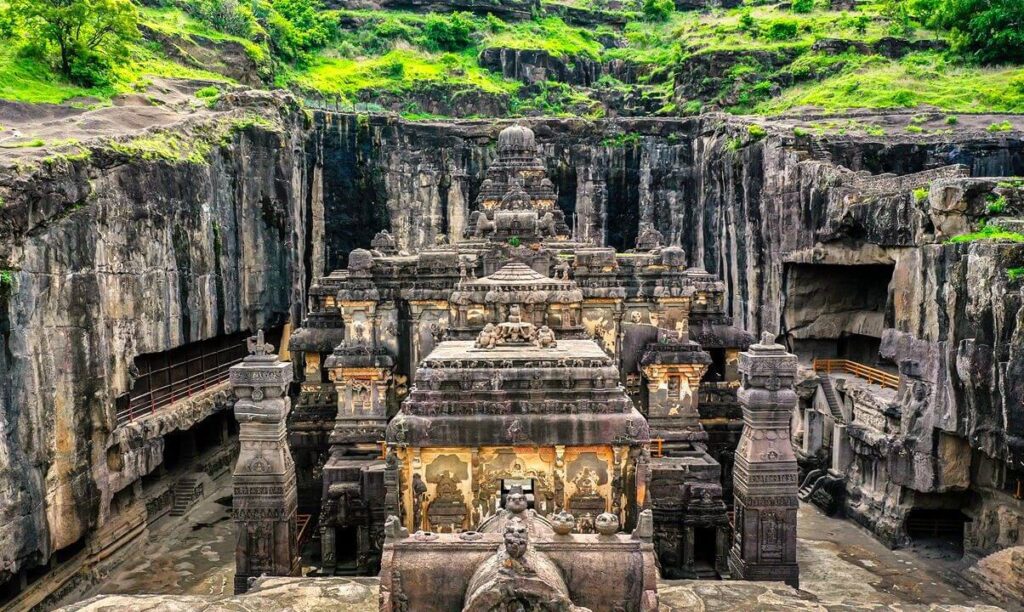
The Ajanta and Ellora Caves in Maharashtra are among the most stunning examples of ancient Indian art and architecture. Together, they showcase the brilliance of Buddhist, Hindu, and Jain traditions.
The Ajanta Caves consist of 30 rock-cut monuments, dating back from the 2nd century BC to 650 AD. These caves were used as places for living, learning, and worship. During the monsoon, Buddhist monks used them as chaityas (prayer halls) and viharas (monasteries). The walls of Ajanta are decorated with beautiful murals, paintings, and sculptures, many of which depict the Jataka tales – stories from the life of Buddha.
On the other hand, the Ellora Caves have 34 rock-cut caves, created between 350 AD and 700 AD. These caves include Buddhist monasteries, Hindu temples, and Jain shrines, reflecting the religious harmony of ancient India.
The most remarkable of all is the Kailash Temple at Ellora, a massive structure carved entirely out of a single rock. This temple is considered a true man-made wonder, showcasing extraordinary skill and craftsmanship that leaves visitors in awe.
Today, the Ajanta and Ellora Caves are not just historical sites but also UNESCO World Heritage Sites and major tourist attractions. They continue to fascinate visitors with their artistic beauty, spiritual significance, and architectural brilliance.
Jain Statue, Shravanbelagola

The Jain Statue at Shravanbelagola in Karnataka is one of the most sacred pilgrimage sites for Jains. The site is famous for its 57-foot-tall statue of Lord Bahubali (also known as Gomateshwara), which is considered an architectural marvel of India.
According to Jain tradition, Bahubali was the son of Rishabhadeva (Adinath), the first Tirthankara and the founder of Jainism. Bahubali renounced his kingdom to live as a monk, and by attaining moksha (liberation), he became a revered figure in the religion.
The statue was built in 983 AD by Chamundraya, a minister of the Ganga Dynasty. Carved out of a single rock monolith, the statue stands on Vindhyagiri Hill, at a height of about 3,350 feet above sea level.
Every 12 years, the site hosts the Mahamastakabhisheka festival, where the statue is anointed with milk, saffron, and other sacred substances, attracting thousands of devotees and visitors from around the world.
Today, the Gomateshwara statue is not just a symbol of faith and spirituality, but also a testimony to ancient Indian craftsmanship and devotion.
Meenakshi Temple
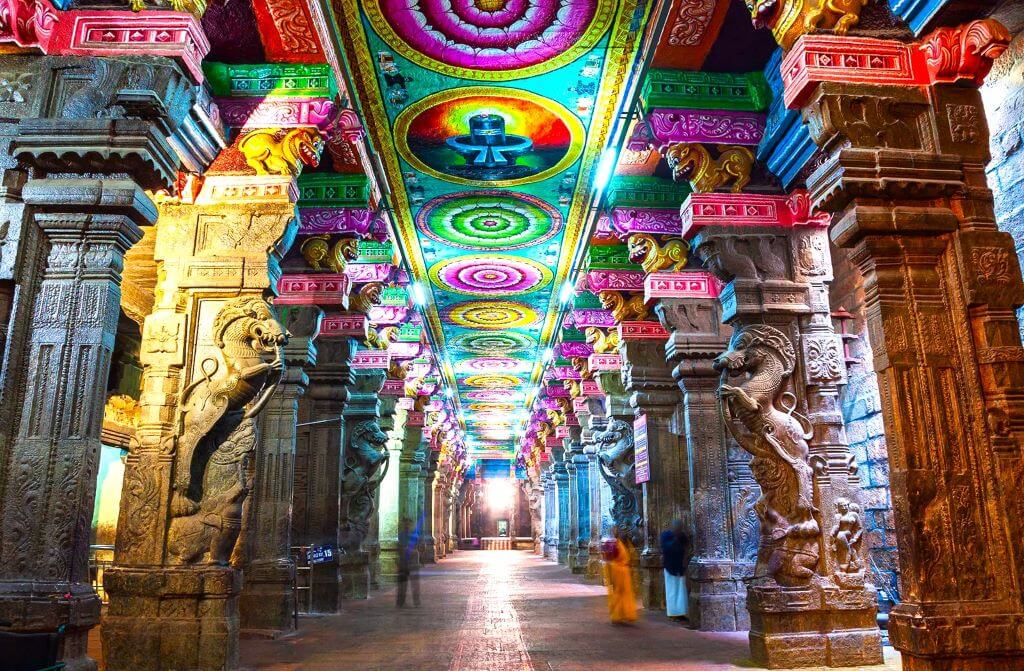
The Meenakshi Temple in Madurai, Tamil Nadu, is one of the most famous and magnificent examples of South Indian temple architecture. Dedicated to Goddess Meenakshi (a form of Parvati) and Lord Sundareswarar (Shiva), this temple is both a spiritual center and a cultural treasure.
It is one of the largest temples in India, spread over 45 acres. The temple is known for its 12 towering gopurams (gateway towers), covered with thousands of colorful sculptures of gods, goddesses, and mythical creatures. The tallest gopuram stands at nearly 170 feet, making it a striking landmark of Madurai.
Inside the temple, you will find a sacred tank, the famous Hall of a Thousand Pillars, and many other halls decorated with intricate carvings and sculptures, each with its own unique design. The artistry and detailing make the temple an unforgettable sight.
Though the temple was damaged during the Islamic invasions, it was beautifully restored in the 17th century by King Vishwanatha Nayak of Madurai. Since then, it has stood as a symbol of faith, devotion, and artistic excellence.
Today, the Meenakshi Temple is not just a major pilgrimage site for Hindus but also a UNESCO World Heritage nominee and a must-visit destination for travelers from around the world.
Chand Baoli

The Chand Baoli in Rajasthan is one of the deepest and largest stepwells in the world. Built in the 9th century AD, it was designed to provide water to the people of the nearby village, especially in the hot and dry climate of the region.
The stepwell is square-shaped and about 100 feet deep, with a perimeter of 140 meters. It has more than 3,500 narrow steps arranged in a precise geometric pattern, leading down to the water at the bottom.
What makes Chand Baoli fascinating is the brilliant architectural and engineering skills of the local people of that time. The design not only provided a reliable water source but also kept the water cool, making it an important community space.
Today, Chand Baoli is admired as a remarkable example of vernacular architecture, showcasing how traditional design was closely linked with both functionality and beauty. It is also a popular tourist attraction, drawing visitors who are amazed by its symmetry and scale.
Amber Fort Jaipur
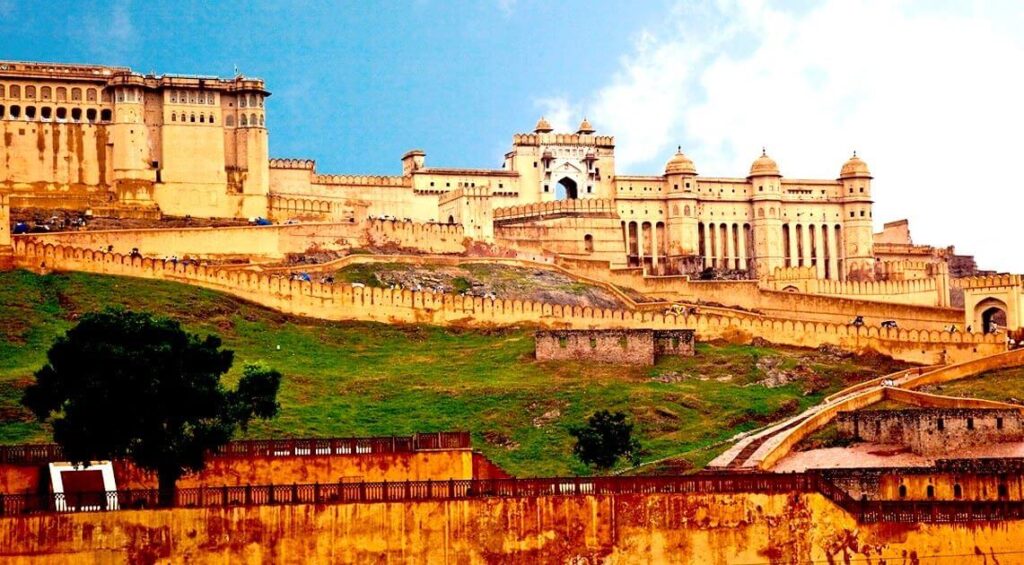
The Amber Fort (also called Amer Fort) is one of the most famous hill forts of Rajasthan, located just 11 km from Jaipur, the Pink City. Built with red sandstone and white marble, this fort is a grand example of Rajputana architecture combined with Hindu design elements.
The fort reflects the royal lifestyle and rich cultural heritage of Rajasthan. Inside, you will find beautifully decorated palaces, courtyards, halls, and temples, each showcasing artistic carvings, mirror work, and paintings.
One of the most interesting features of Amber Fort is its self-sustaining design. It has the Maota Lake as a permanent water source and an advanced ventilation system that kept the interiors cool during the hot summers. These features highlight the brilliance of ancient engineering.
Today, Amber Fort is not just a historic monument but also a UNESCO World Heritage Site. Visitors are drawn to its majestic architecture, rich history, and stunning hilltop views, making it a must-visit when exploring Jaipur.
IIM Ahmedabad
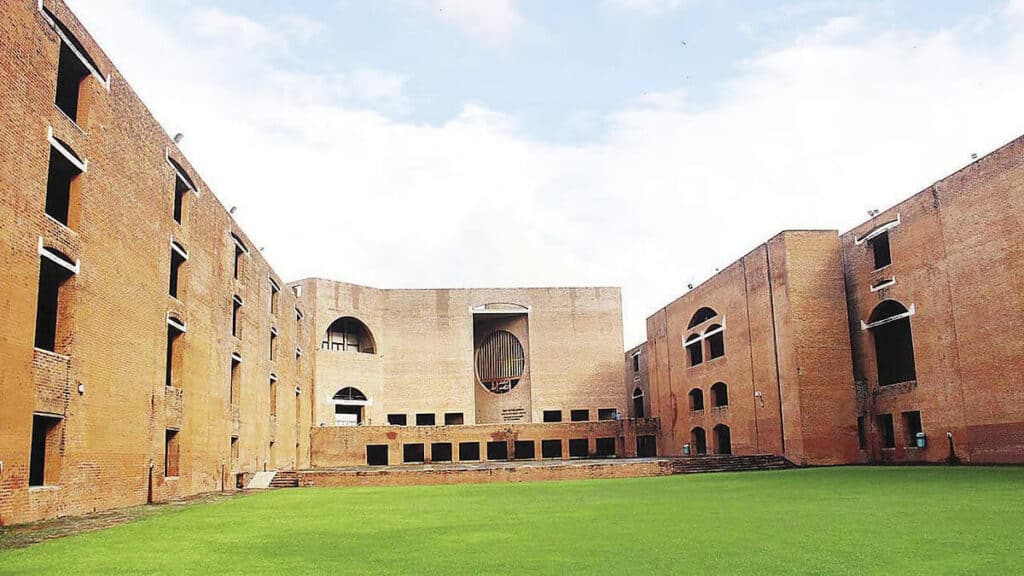
The Indian Institute of Management (IIM) Ahmedabad is not only one of the top management institutes in India but also an architectural landmark. Designed by the world-renowned American architect Louis I. Kahn, this building is considered one of the finest examples of institutional architecture in the country.
What makes IIM Ahmedabad special is its blend of modern and traditional design. Kahn used elements of Indian vernacular architecture, especially in the choice of materials like exposed red brick, which gives the campus its iconic look.
The architecture is based on geometric shapes and patterns, creating impressive arches, circles, and squares. These forms not only define the building’s style but also make the design functional. The use of voids in the façade allows natural light and ventilation, adding to its brilliance.
The campus is planned in such a way that it includes classrooms, plazas, and wide hallways, which encourage open interaction and learning. This thoughtful design makes the space feel both grand and inviting.
Today, IIM Ahmedabad stands as a symbol of modern Indian education and remains an inspiration for architects, designers, and students alike.
Konark Temple, Odisha
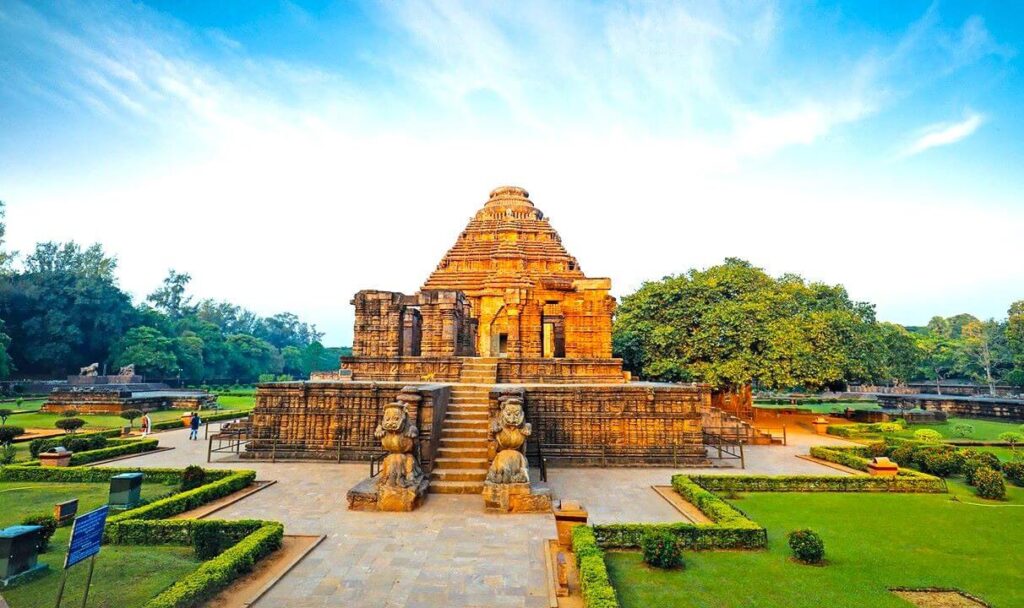
The Konark Sun Temple in Odisha is one of the most spectacular monuments in India and a UNESCO World Heritage Site. Built in the 13th century AD by King Narasimhadeva I, the temple is designed in the form of a grand chariot of the Sun God (Surya), pulled by seven pairs of galloping horses.
The temple is a masterpiece of Odisha’s temple architecture and follows the Shikhara style of design. Its walls are covered with minute carvings of human figures, animals, deities, and mythological scenes, which leave visitors amazed at the craftsmanship.
Although the main sanctum, dining hall, and dancing hall have not survived fully over the years, the audience hall (Jagamohan) still stands strong and continues to fascinate travelers and historians.
Another remarkable feature of the Konark Temple is its vast size – the temple complex measures about 857 feet by 540 feet, making it one of the largest temples in India.
Today, the Konark Sun Temple is admired not only as a spiritual and cultural landmark but also as an architectural wonder, attracting tourists, historians, and devotees from across the world.
Akshardham Temple New Delhi
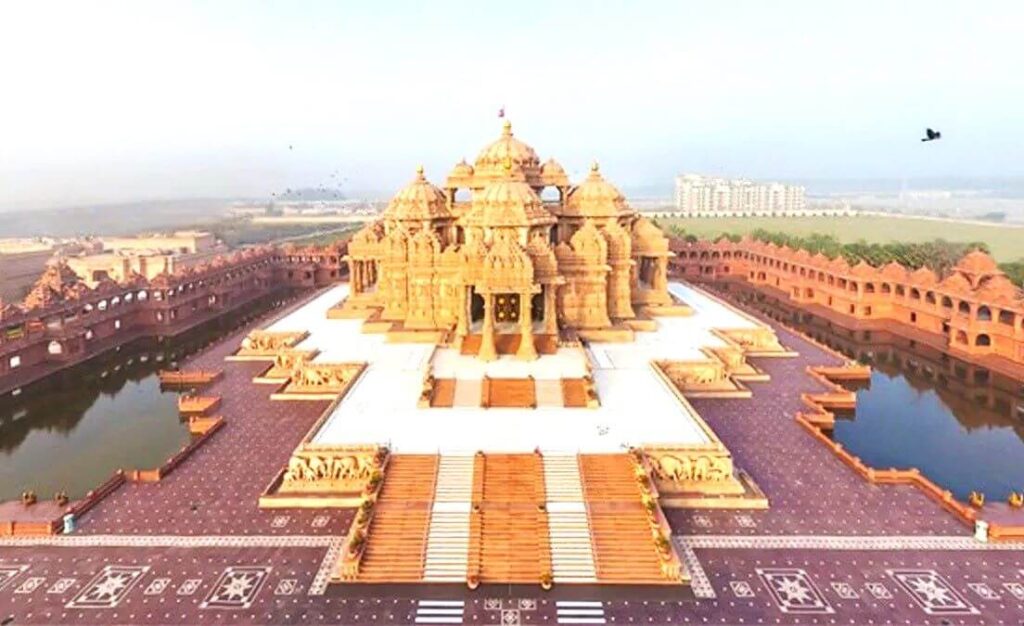
The Akshardham Temple in New Delhi is one of the most breathtaking modern temples in India and a true example of Indian art, culture, and spirituality. Located near the banks of the Yamuna River, this massive temple attracts millions of visitors every year.
What makes Akshardham so special is that it is built entirely of pink sandstone and white marble, with no steel or iron used in its construction. The temple has 234 beautifully carved pillars, 9 grand domes, 20 shikharas (spires), and nearly 20,000 statues of gods, sages, and spiritual leaders. Each carving and sculpture reflects the rich traditions and philosophies of India.
The temple is dedicated to Bhagwan Swaminarayan and showcases his life and teachings. Spread over a vast area, the complex also offers cultural exhibitions, musical fountain shows, and spiritual films, making the visit both inspiring and memorable.
It is said that around 11,000 craftsmen worked on this magnificent structure, which stands as tall as a 10-story building. The detailing, craftsmanship, and scale of Akshardham make it one of the finest modern architectural wonders of India.
Today, the Akshardham Temple is not just a place of worship but also a symbol of India’s timeless heritage and spiritual beauty.
Jantar Mantar, Jaipur
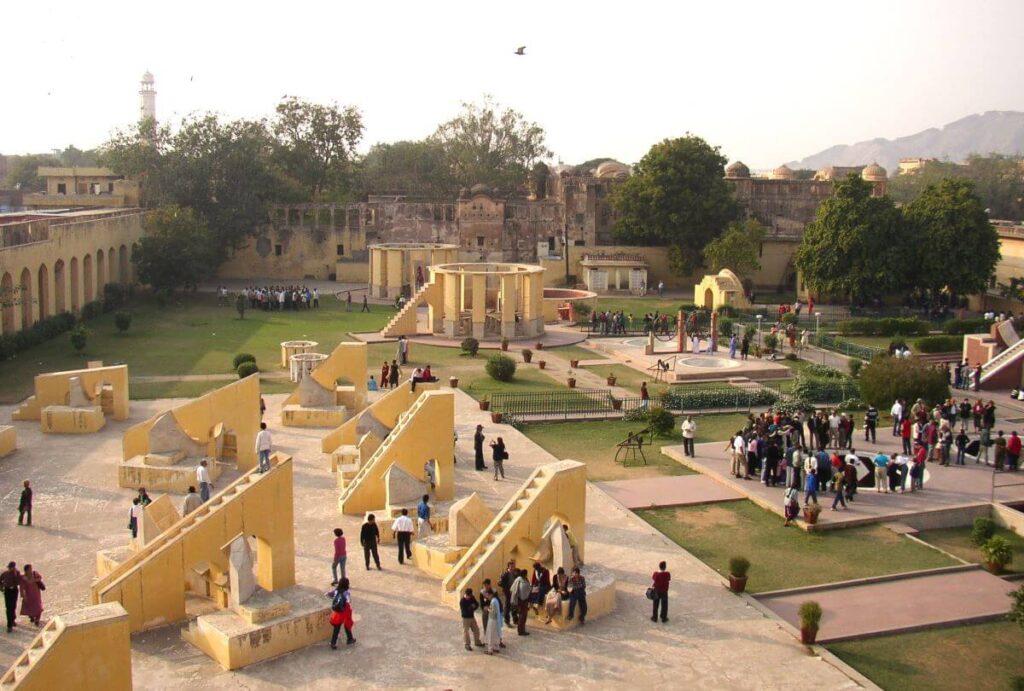
The Jantar Mantar in Jaipur is one of the most fascinating monuments in India and a UNESCO World Heritage Site. Built in the 18th century by Maharaja Sawai Jai Singh II, it reflects his deep interest in astronomy and science.
This is the largest stone observatory in the world and is famous for its giant sundial, which can measure time with remarkable accuracy. The instruments here were designed to track the movements of the sun, moon, and stars, and to calculate time, eclipses, and celestial positions.
Inside the complex, you can see structures like the Samrat Yantra (the giant sundial), the Hindu Chhatri, and the Jaiprakash Yantra, each serving a specific astronomical purpose. These devices are not only scientifically significant but also display brilliant architectural creativity.
Jantar Mantar stands as a symbol of India’s scientific heritage and the vision of a ruler who combined royal power with knowledge. Today, it is a must-visit site for tourists, historians, and anyone curious about the blend of science and architecture.
Tawang Monastery, Arunachal Pradesh
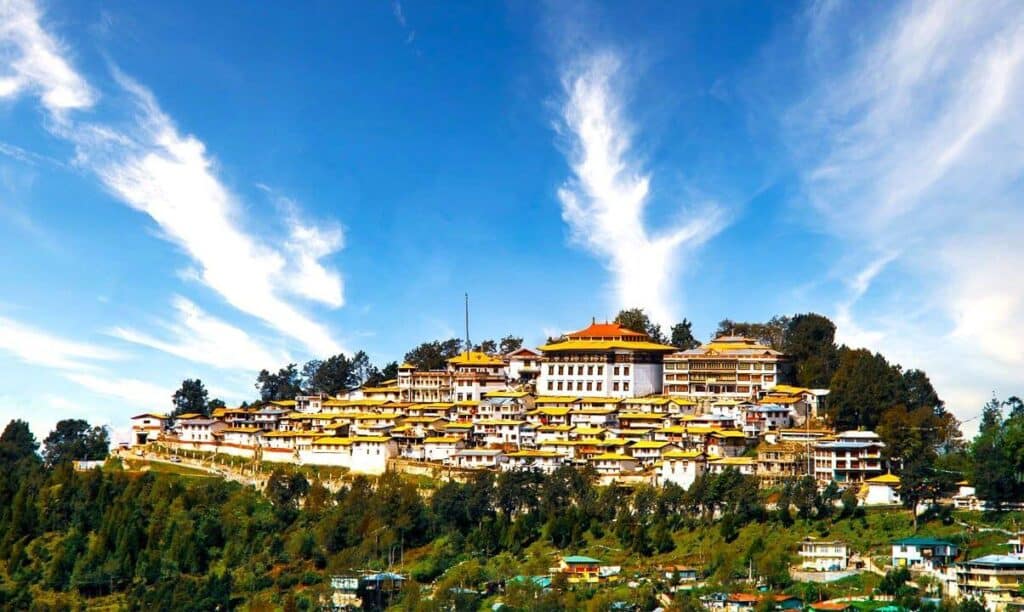
The Tawang Monastery in Arunachal Pradesh is one of the most important Buddhist sites in India and the second-largest monastery in the world. Located at a height of about 10,000 feet above sea level, it offers both spiritual peace and breathtaking views of the Himalayas.
The monastery was founded around 1680 AD by Merak Lama, following the wishes of the 5th Dalai Lama. Since then, it has remained a center of faith, learning, and culture for Buddhists.
The entrance of the monastery is truly striking, with a colorful gate decorated with murals of Buddhist saints and holy figures. Inside, the main building resembles a large mansion with three floors, which also provides residential quarters for monks and students.
The heart of the monastery is the Dukhang (assembly hall). This hall houses a majestic statue of Lord Buddha seated in the lotus position, surrounded by beautiful paintings and religious scriptures.
Today, the Tawang Monastery is not only a spiritual center for Buddhists but also a major cultural and architectural landmark that attracts visitors from around the world.
Victoria Memorial Kolkata
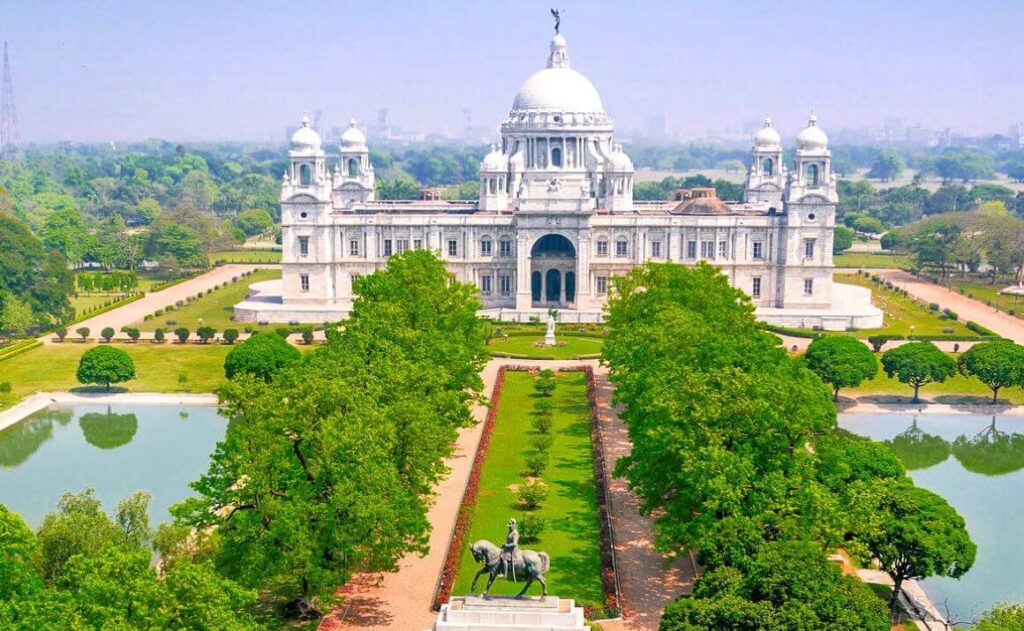
The Victoria Memorial in Kolkata is one of the most famous landmarks of colonial India. It was built in memory of Queen Victoria, who passed away in 1901, and today it stands as a reminder of the British era in India.
Designed by architect William Emerson, the building is a blend of several styles, including Indo-Saracenic, Mughal, Venetian, Egyptian, Islamic, and Deccani architecture. This mix of influences gives the memorial its unique and majestic appearance.
The structure is made of white Makrana marble, which makes it shine beautifully, especially under the evening sun. The memorial is surrounded by lush gardens, adding to its charm and elegance.
Today, the Victoria Memorial functions as a museum, showcasing a wide collection of paintings, coins, artifacts, and memorabilia from British India. It not only attracts history lovers but also art and architecture enthusiasts.
The Victoria Memorial remains one of the most important tourist attractions of Kolkata, symbolizing the city’s rich blend of Indian and colonial heritage.
Golconda Fort
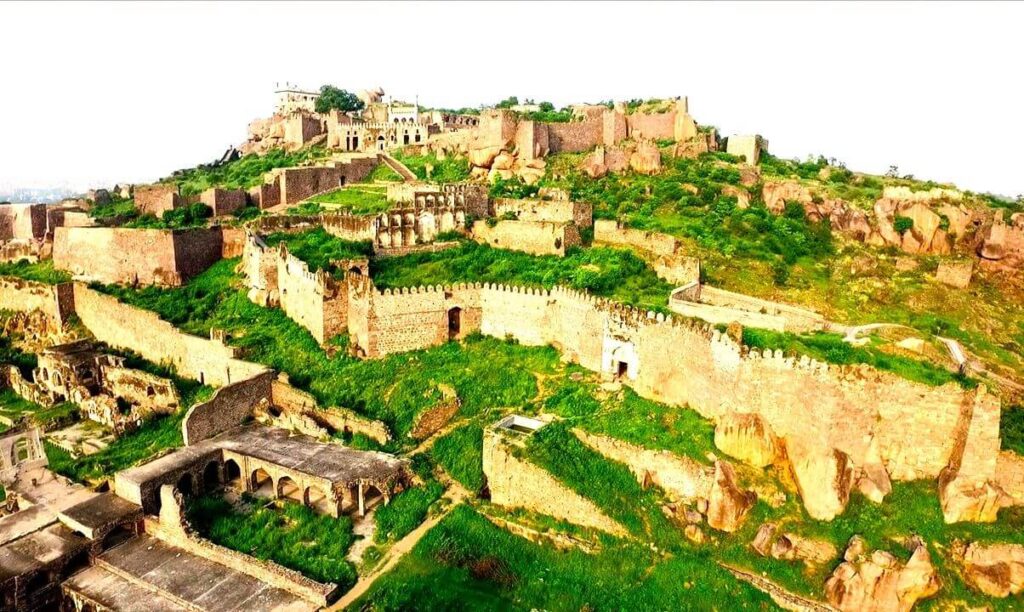
The Golconda Fort, meaning “Shepherd’s Hill”, is a majestic hill fortress located near Hyderabad, Telangana. Once the capital of the Golconda kingdom, it has a long and fascinating history.
Originally built by the Kakatiya dynasty, the fort later came under the Bahamani rulers, and eventually the Qutb Shahi dynasty. Later, it was controlled by the Nizams until 1948. Over the centuries, the fort became famous for its strategic design, grandeur, and historical importance.
Inside the fort complex, you can find royal apartments, mosques, halls, and parade grounds. The most striking feature is the Fateh Darwaza (Victory Gate), which is 13 feet wide and 25 feet high, fitted with iron spikes to block war elephants. The Eastern Gate, however, is the main entrance for visitors today.
The architecture of Golconda Fort is unique. It had excellent ventilation systems that kept the interiors cool during the scorching summers. The fort is also famous for its amazing acoustic system—a clap at the entrance gate can be heard clearly at the top of the fort, several hundred meters away. This system was once used to alert soldiers of enemy attacks.
Legends also say that the fort had underground escape tunnels, which were used by the rulers as a secret defense route during battles.
Today, the Golconda Fort is one of the most popular attractions in Hyderabad, admired for its history, architecture, and engineering brilliance.
India Gate, New Delhi
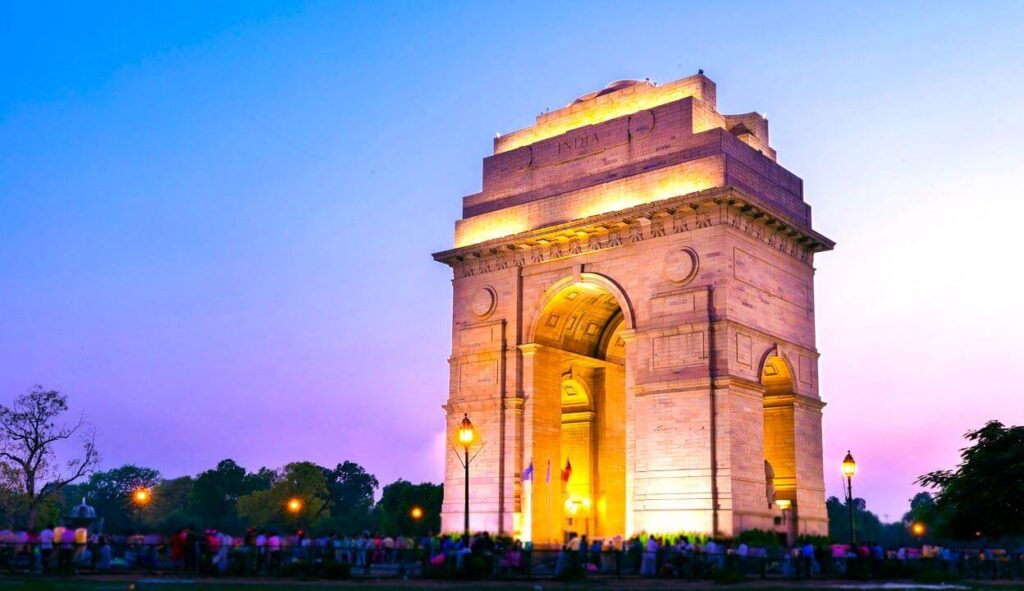
The India Gate in New Delhi is one of the most famous landmarks of India. It was built to honor the Indian soldiers who lost their lives during World War I and the Anglo-Afghan War while fighting for the British Army.
Designed by the well-known architect Sir Edwin Lutyens, the structure is a grand 42-meter-high arch made of sandstone, with a width of about 10 meters. The walls of the memorial are inscribed with the names of over 13,500 soldiers who sacrificed their lives in battle.
In 1971, after the India–Pakistan war, the Amar Jawan Jyoti (Flame of the Immortal Soldier) was added under the arch to honor the soldiers who died defending the nation. Since then, it has become a symbol of respect, bravery, and sacrifice.
Today, the India Gate stands not just as a war memorial, but also as a popular tourist attraction and national pride. Every evening, the area is beautifully lit up and attracts countless visitors who come to pay tribute and enjoy the vibrant atmosphere.
Famous For: Honoring fallen Indian soldiers and the eternal flame of Amar Jawan Jyoti.
Mysore Palace, Mysore
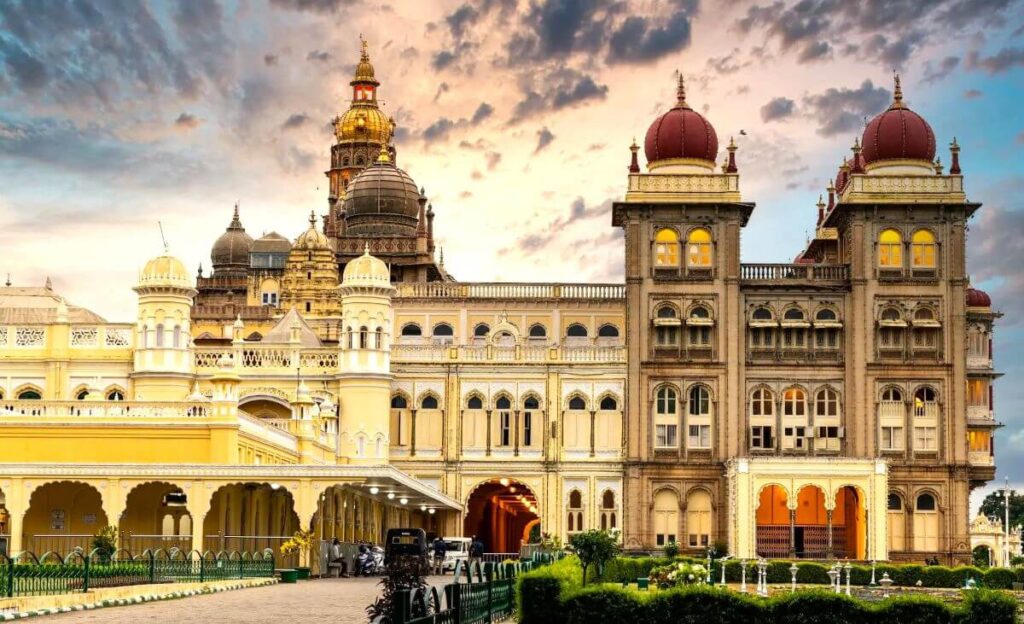
The Mysore Palace is the most famous landmark of Mysore and one of the top tourist attractions in India. It was once the royal residence of the Wodeyar dynasty, who ruled the region from 1350 to 1950. Originally built in wood, the palace was destroyed in a fire in 1897 and later rebuilt into the grand structure we see today.
The palace is a stunning example of Indo-Saracenic architecture, blending Hindu, Muslim, Rajput, and British styles. Its luxurious interiors feature marble floors, intricately carved doors, stained glass ceilings, and exotic artworks. Today, the palace functions as a museum, showcasing royal costumes, jewelry, paintings, and artifacts that reflect the lifestyle of Mysore’s kings and queens.
Every year, nearly 6 million people visit Mysore Palace, making it the second most visited tourist attraction in India after the Taj Mahal. During festivals like Dussehra, the palace is illuminated with over 90,000 lights, creating a truly magical sight.
Famous For: Its royal heritage, Indo-Saracenic architecture, and grand illumination during Dussehra.
Lotus Temple, New Delhi
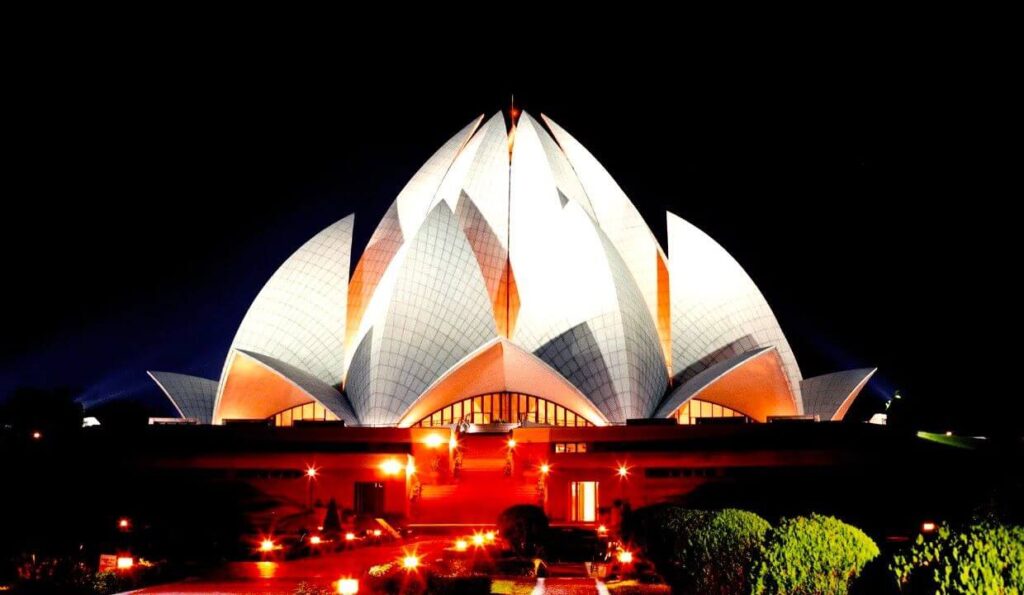
The Lotus Temple in New Delhi is one of the most iconic modern landmarks of India. It is a Bahá’í House of Worship, welcoming people of all faiths and beliefs, making it a symbol of unity and peace. Completed in 1986, the temple was designed by renowned Iranian architect Fariborz Sahba.
True to its name, the structure resembles a lotus flower, with 27 white marble petals arranged in clusters of three to form nine sides. The central prayer hall, soaring 40 meters high, can accommodate nearly 2,500 visitors at a time. Spread across 16 acres, the temple is surrounded by lush gardens and serene ponds, offering a tranquil environment away from the city’s bustle.
The Lotus Temple is not just admired for its unique architecture, but also for its message of harmony, inclusiveness, and spiritual calm. It is one of the most visited monuments in Delhi, drawing millions of visitors every year.
Famous For: Its lotus-inspired design, Bahá’í faith philosophy of unity, and peaceful ambiance.
Chhatrapati Shivaji Terminus, Mumbai
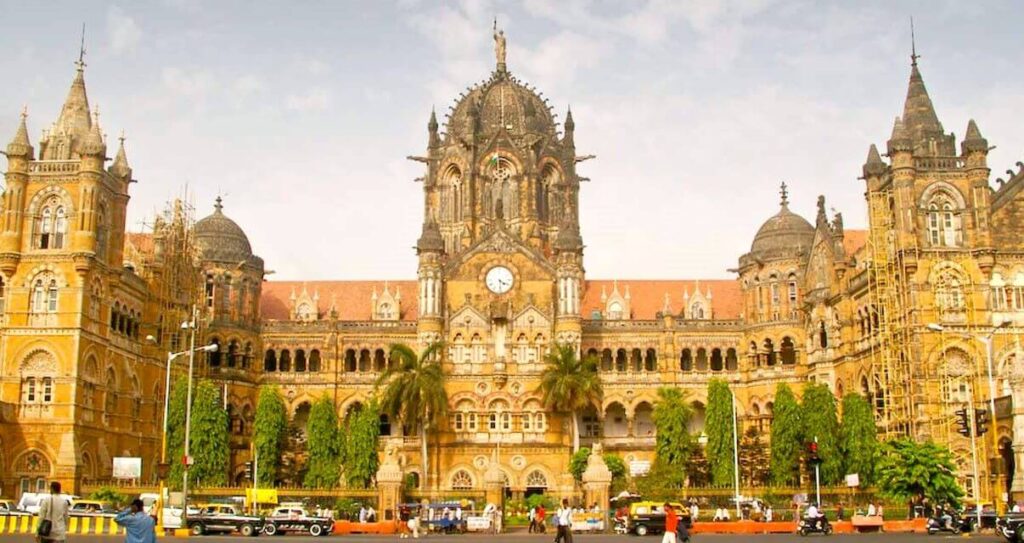
The Chhatrapati Shivaji Terminus (CST) in Mumbai, formerly known as Victoria Terminus, is one of the most stunning railway stations in the world and a UNESCO World Heritage Site. Designed by F.W. Stevens, its construction began in 1878 and was completed in 1888, taking nearly a decade to finish.
The station is a blend of Victorian Gothic Revival architecture and traditional Indian design. Its structure features carved turrets, pointed arches, a grand central dome, and large stained-glass windows. The layout of the building is in a C-shape, perfectly balanced on its east and west axes, making it both functional and beautiful.
CST holds a special place in India’s railway history, as it was from here that the first passenger train of India ran. Today, it is still the busiest railway station in Mumbai, with nearly 3 million passengers passing through daily. Despite the rush, it remains one of the finest examples of colonial-era architecture in India, and a must-visit landmark in Mumbai.
Famous For: Victorian Gothic design, historical importance, and being Mumbai’s busiest railway hub.
Nalanda University, Bihar
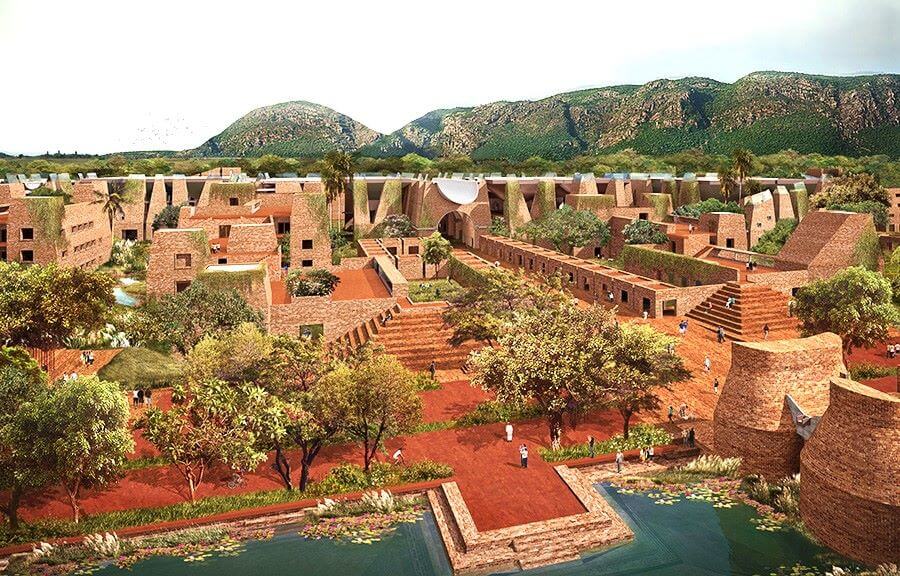
Nalanda University was one of the greatest centres of learning in ancient India, flourishing between the 5th and 12th centuries AD. Located in Bihar, it was a vast Buddhist monastery and educational hub that thrived under the rule of the Gupta and Pala kings.
This university was world-famous and attracted students from distant lands such as China, Tibet, Korea, Sri Lanka, and even Indonesia. At its peak, Nalanda could house around 10,000 students and 1,000 teachers. It was renowned for its vast library and manuscripts, making it a treasure of knowledge in philosophy, medicine, astronomy, mathematics, and Buddhist studies.
Legends say that Lord Buddha himself visited Nalanda, and even Emperor Ashoka contributed to its growth. Unfortunately, Nalanda declined in the 12th century after being destroyed by the Muslim invader Bakhtiyar Khilji, leading to the loss of invaluable texts and teachings.
Today, the ruins of Nalanda are a UNESCO World Heritage Site, reminding the world of India’s glorious contribution to education and knowledge.
Famous For: One of the world’s oldest universities and a UNESCO World Heritage Site.
Hampi, Karnataka

Hampi, the former capital of the Vijayanagar Empire in the 14th century, is one of the most fascinating historical sites in India. Spread across 26 square kilometers, the city was naturally protected by the Tungabhadra River on one side and rugged granite hills on the other three.
Hampi was a thriving hub of culture, trade, and architecture, dotted with magnificent temples, palaces, and monuments. Its architecture reflects a blend of Dravidian (Tamil) style and Indo-Islamic designs, popularly known as the Indo-Saracenic style. Historians classify the monuments here into three groups—civil, military, and religious structures, each built with unique features and purposes.
From intricately carved temples like the Virupaksha Temple to the royal enclosures and grand bazaars, every corner of Hampi narrates stories of its glorious past. Today, Hampi is a UNESCO World Heritage Site and a popular destination for travelers who love history, architecture, and ancient art.
Famous For: Ruins of the Vijayanagar Empire and UNESCO World Heritage Site
Closing Thoughts
India is truly a treasure trove of history, culture, and architecture. From the mighty forts of Rajasthan to the serene temples of Tamil Nadu, from the grandeur of colonial-era buildings to the timeless ruins of Hampi and Nalanda, every structure tells a story of the country’s glorious past. These monuments are not just architectural masterpieces but also a reflection of the diverse dynasties, faiths, and traditions that shaped India over centuries.
For travelers, exploring these iconic sites is like stepping back in time—whether you admire the acoustics of Golconda Fort, marvel at the beauty of the Lotus Temple, or walk through the royal corridors of Mysore Palace. Each monument offers a glimpse into India’s soul, leaving behind memories that last a lifetime.
If you are passionate about history, culture, or simply love to witness breathtaking art and architecture, India welcomes you with open arms and countless stories etched in stone.
FAQ About Best Architectural Buildings in India
The Taj Mahal in Agra is the most visited monument in India. It attracts millions of tourists every year from all over the world.
The Taj Mahal is known as the symbol of love. It was built by Mughal Emperor Shah Jahan in memory of his wife Mumtaz Mahal.
The best time to explore monuments in India is from October to March, when the weather is pleasant for sightseeing.
Nalanda University in Bihar is considered the oldest university in India, dating back to the 5th century AD.
Mysore Palace is one of the most famous and most visited palaces in India, attracting nearly 6 million visitors annually.
Jaipur, also called the “Pink City,” is widely known for its forts, palaces, stepwells, and unique architectural designs.
Most monuments in India are open to tourists, but some may have restricted areas due to preservation efforts. It’s best to check timings and entry rules before visiting.
It’s not mandatory, but having a guide can make the visit more informative and help you understand the history, culture, and architectural details better.
India has a mix of architectural styles, including Mughal, Indo-Saracenic, Rajputana, Dravidian (South Indian temples), and Colonial British architecture.
Some must-visit UNESCO sites include the Taj Mahal (Agra), Qutub Minar (Delhi), Chhatrapati Shivaji Terminus (Mumbai), Hampi (Karnataka), and Sun Temple (Konark).




